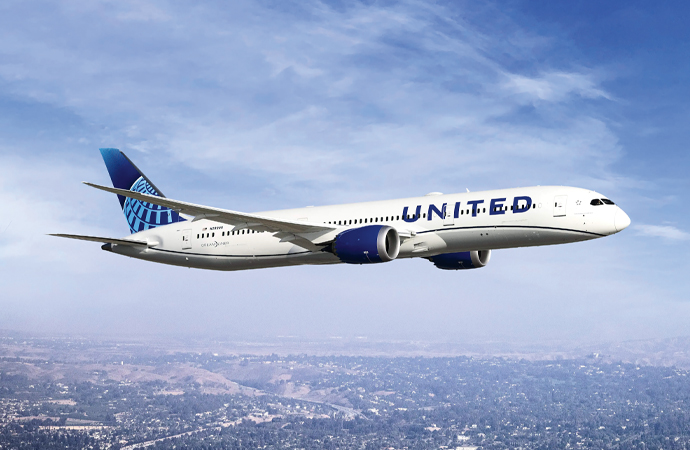“It’s going to be a rough summer for air travel.” That’s the message we’ve heard loud and clear from airlines, analysts and the Federal Aviation Administration (FAA). And this isn’t just due to summer travel demand returning to normal after years of fitful recovery. Instead, airlines are still trying to figure out a “new normal” while also dealing with complicating factors, from FAA staffing shortages to aircraft manufacturing delays.
Airlines Warn of Full Flights This Summer
The warnings about a busy summer amped up in mid-April. During Delta’s first-quarter conference call, CEO Ed Bastian noted that the airline was experiencing “record advance summer bookings.” President Glen Hauenstein added that the Atlanta-based airline had already sold 75 percent of seats on international flights and was “seeing strong demand on our largest-ever summer schedule” between the U.S. and Europe.
These full aircraft are despite Delta significantly increasing the number of flights this summer—particularly on international routes. “To meet demand, we are growing our international seats by more than 20 percent in the June quarter compared to the prior year,” Hauenstein explained on the call. Delta’s 32 European destinations this summer include new routes from New York to Geneva and Berlin and from Atlanta to Düsseldorf and Edinburgh.

United Airlines’ long-haul fleet includes the Boeing 787-8, -9 and -10 Dreamliner / Photo: Courtesy of United Airlines
If 20-percent growth sounds significant, Delta lags behind United’s expansion in international markets. In its mid-April earnings call, United management shared that it grew its transatlantic capacity by 39 percent year over year. This summer United will fly an average of 207 daily flights across the Atlantic, including to new destinations such as Málaga, Dubai and Stockholm, plus additional flights to Rome, Paris, Barcelona, Berlin, Shannon, Edinburgh and Naples.
“We expect to expand international flying by approximately twice the rate of domestic,” said United chief commercial officer Andrew Nocella, “leaning into the favorable supply-demand balance that we expect.” United’s astonishing growth has helped the airline claim the titles of largest airline across the Atlantic, largest airline across the Pacific, and even largest airline in the world by available seat miles. This accomplishment was celebrated by CEO Scott Kirby via an internal memo to employees.
American Airlines is also banking heavily on international flights as part of its expansion. More than 80 percent of the airline’s year-over-year capacity growth is found on long-haul routes. To fuel its growth, American Airlines is doubling down on leisure markets. Rather than adding more flights to connect passengers through its partner hubs in Madrid and Helsinki, American has grown Rome into its second-largest European destination, with seven flights per day during peak summer travel.
While airlines love to boast about new routes, a sizable amount of transatlantic traffic is still concentrated in just a few markets. According to data compiled by Cirium, airlines will fly more than 20,000 flights from North America this month. Nearly a quarter will depart from the New York area, and just under a quarter will land in London, followed by Paris, Frankfurt, Amsterdam and Reykjavík.
Three Factors Impacting Summer Flights
These warnings about full flights lead to the obvious question: What’s different this year? While demand is undoubtedly higher in 2023, airlines can typically grow to meet it. However, a trio of factors is keeping carriers from ramping up flights.
One main limitation is simply a lack of large aircraft. When the pandemic nearly canceled air travel, airlines scrambled to store planes quickly to reduce costs. While most went into temporary storage, some were retired for good. For instance, American Airlines eliminated its entire fleet of Airbus A330 and Boeing 757/767 aircraft. Likewise, Delta retired all its Boeing 777 and MD-88/90 fleet.
Now these aircraft retirements are coming back to bite the airlines. American counted on Boeing to deliver newly ordered 787 wide-body planes to build back its international capacity. However, Boeing’s persistent delays have put a dent in those plans. As a result, despite healthy demand, the airline’s international capacity won’t reach 2019 levels.
Even in its bullish earnings call, Delta admitted that its growth was still “a couple of points below our initial plan to fully restore capacity this summer.” The airline’s executives cited “constraints around the supply chain, aircraft delivery delays and training needs.” Henry Harteveldt, airline industry analyst and founder of Atmosphere Research Group, told Business Traveler, “Some airlines may be regretting retiring certain aircraft early.”
While Harteveldt wouldn’t call out any particular airline, American is likely ruing its aircraft retirements. In its late-April earnings call, chief commercial officer Vasu Raja noted that the airline had approximately 45 fewer long-haul planes than in 2019. That means it’s well short of replacing the 24 Airbus A330 and 51 Boeing 757/767 aircraft it retired in early 2020. At this point, American Airlines surely would like to have those nearly 16,000 seats back in its fleet. “We need them to get their act together,” American Airlines CEO Robert Isom said bluntly of Boeing’s delays.
Even if airlines had all the planes they wanted, two other factors limit the number of flights they can operate this summer. First, in March, the FAA went public about dire staffing shortages. In a notice urging airlines to cut back flights this summer, the FAA noted that staffing levels were 19 percent short of targets nationwide. In parts of the critical New York airspace, air-traffic-control staffing had fallen to just 54 percent of targeted levels.
How did the staffing situations get so dire? “Even though the FAA has been hiring more air-traffic controllers, they’re still playing catch-up from being unable to hire and train enough new controllers in 2020 and 2021, when Covid restrictions were at their most severe,” explains Harteveldt. “The FAA requires air-traffic controllers to retire at the age of 56, and the calendar didn’t stop during Covid.” To relieve some of the pressure, the FAA let airlines cancel up to 10 percent of flights in and out of slot-controlled airports—JFK, LaGuardia, Newark and Washington Reagan—without losing access to those landing slots in the future.
However, these cuts alone may not be enough for peak summer travel. Even when staffing levels were normal, delays could snowball during this busy period—especially when bad weather passes through. “Bad weather accounts for nearly two-thirds of flight delays and cancellations in the U.S.,” Harteveldt says. “And we’ve already seen, far too often, that staffing problems at certain key centers can wreak havoc on flights.”
And if the lack of aircraft and FAA staffing shortages weren’t bad enough, airlines are also facing pilot shortages. For now, these are mostly being felt at regional airlines. A mid-April report noted a whopping 500 regional jets were parked in the U.S. due to a lack of pilots, leading to drastic reductions in service at many airports.
In recent congressional testimony, the Regional Airline Association noted that “308 airports in the U.S., or almost 72 percent, have less air service now than they did prior to the pandemic.” That includes 11 airports that have lost all scheduled flights and 136 airports that have lost more than 25 percent of their service when comparing April 2023 to 2019. Between pilot shortages and FAA staffing limitations, travelers near smaller airports will likely find far fewer flight options than before the pandemic. And unfortunately, an easy fix isn’t in sight as a “coming tsunami of pilot retirements” threatens to also impact mainline carriers.
Leveraging Loyalty Programs This Summer
Traditionally, travelers have joined airline loyalty programs to earn miles for free flights and score elite status. However, infrequent travelers may not have bothered to sign up, assuming they might not earn enough miles for a free flight or status.
However, a few factors have changed over the past couple of years, making it a lot more appealing to sign up for a flight-loyalty program this summer. First, several airlines have ditched mileage expiration. Delta SkyMiles, United MileagePlus and Southwest Rapid Rewards points no longer expire as long as your account is open. Meanwhile, Alaska’s Mileage Plan program merely requires you to “reactivate” your miles after two years of inactivity.
Also, airlines are starting to offer perks just for being a loyalty-program member. The best example is American Airlines, which gives a better boarding group to all members of its AAdvantage program. And you’ll get preferred boarding after earning just 15,000 Loyalty Points—less than halfway to its lowest-tier Gold elite status.
Mileage programs are much more rewarding when airfares are high. Almost all major airlines have transitioned to a revenue-based earning system where you earn miles based on what you spend rather than how far you fly.
Say you splurge, spending $4,000 for a round-trip business-class flight to Europe. American, Delta and United offer non-elite members five miles per dollar spent. That means you’ll earn around 20,000 miles on just this one flight. That can be enough for a free round-trip domestic flight during off-peak times.
If you’re looking for the best flight-loyalty program, there isn’t a clear winner among the U.S.-based airlines. All three legacy carriers have ditched award charts in favor of dynamically priced awards. With flights filling up, award rates will generally be as sky-high as prices. You can still find plenty of award availability across the Atlantic on American Airlines partner British Airways and Delta partner Virgin Atlantic. However, both U.K.-based airlines charge high fees on award flights, on top of already high London departure taxes and fees.

How Travelers Can Prepare
Between staffing shortages and full flights, air travel isn’t going to be normal this summer. Therefore, if you plan to travel by air in the coming months, we recommend booking as soon as possible.
Most airlines have dropped change fees on both cash and mileage tickets. You can freely make changes on these airlines when the price drops or your plans change. With plenty of disruption likely this summer, make sure to book your flights with a credit card that offers trip delay and cancellation protection. This coverage can reimburse you for expenses incurred during delays caused by bad weather or air-traffic-control issues. Also, be among the first to know about a delay or cancellation by using a free trip-tracking tool such as TripIt or AwardWallet to find out about schedule changes, gate changes and more.
More important, remain flexible and have alternative plans in case issues arise. “Have a plan B ready—and maybe a plan C for good measure,” Harteveldt advises. “Be prepared for things to go wrong and be pleasantly surprised if they don’t.”





